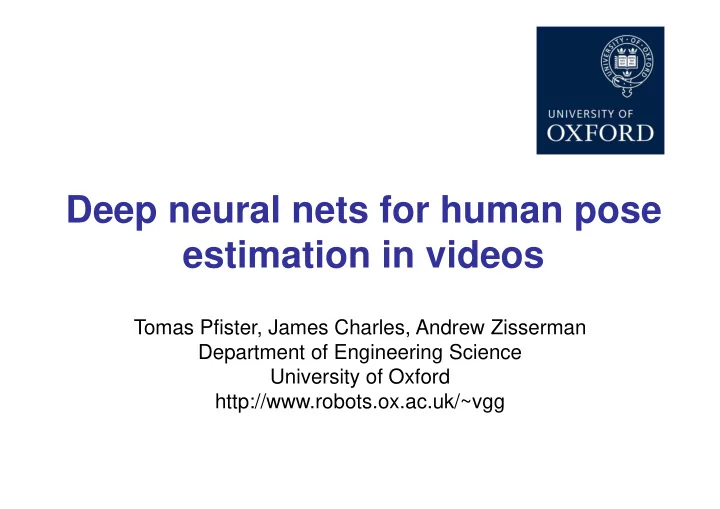

Deep neural nets for human pose estimation in videos Tomas Pfister, James Charles, Andrew Zisserman Department of Engineering Science University of Oxford http://www.robots.ox.ac.uk/~vgg
Aim: Estimate 2D upper body joint positions (wrist, elbow, shoulder, head) with high accuracy in real-time
Outline • Two types of loss functions for pose estimation • Coordinate net • Heatmap net • Optical flow for pose estimation in videos • Results (cf state of the art)
Method overview: single frame learning 1. Coordinate Net e.g. DeepPose CVPR14, Pfister et al ACCV14 2. Heatmap Net e.g. Jain et al ICLR14, Tompson et al CVPR15
Coordinate Net: regress joint positions Training loss: L2 on joint positions OverFeat like architecture
Heatmap Net: regress heatmap for each joint 256 x 256 64 x 64 7 joints Represent joint position by Gaussian Training loss: L2 on pixels
Comparison Regression target Coordinate Net Coordinates Heatmap Net Heatmap
BBC sign language videos data set Training set Training: 15 videos each 0.5-1hr long, all frames annotated Testing: 5 videos, 200 annotated frames per video Extended Training: 72 videos with noisy automated annotations
Results on architecture comparison More training data HeatmapNets CoordinateNets CoordinateNet CoordinateNet - more data HeatmapNet - more data HeatmapNet - data+flow HeatmapNet • Heatmap net superior to coordinate net • Performance of coordinate net saturates with more training data Evaluated on BBC Pose
Why is the heatmap network superior? Regression target 1. Can represent multimodal estimates, so can model uncertainty/confidence 2. In training there is an error signal Coordinates from every pixel, so better smoothing for back propagation Coordinate Net Also, it is easier to visualize (and understand) what is being learnt Heatmap Heatmap Net
Timelapse of training
early in late in training training Multiple modes example
What do the layers learn? Three randomly selected activations from each layer Input frame Edges Body parts (some)
Learning from videos • Temporal information – How do we learn from temporal information with a ConvNet? Hand moving in x direction
Late fusion using flow Warp the heatmaps from previous/next frames & combine Cf S. Zuffi et al., Estimating human pose with flowing puppets. Proc. ICCV, 2013 Charles et al., Upper Body Pose Estimation with Temporal Sequential Forests, BMVC 2014
Optical flow Example: Heatmap Net & Optical flow Tracks for optical flow for wrist positions Flow: Brox et al GPU flow from OpenCV, or FastDeepFlow
Optical flow Example: Heatmap Net & Optical flow Warping heatmaps to frame t
Learn the pooling of the warped heatmaps Flowing ConvNets •
Results: with/without optical flow
Comparison of pooling types Results
wrist Learnt optical flow pooling weights elbow Results
Results Comparison to the state of the art Poses in the Wild 12% improvement at d = 10px
Results: Example pose estimation 50fps on 1 GPU without optical flow, 5fps with optical flow
Results Failure cases Main failure case: Picking the wrong mode BBC Pose ChaLearn Correctable with a spatial model
Additional Pooling Fusion Layers Conv A 8x8x64 256 x 256 Conv B 13x13x64 Conv C 15x15x64 Conv D 1x1x128 Conv E 1x1x7 Implicit spatial model
Results: Additional Pooling Fusion Layers Heat map Poses in the Wild CNNs with fusion and flow with fusion original
Results: Additional Pooling Fusion Layers FLIC: single image predictions
Summary • Deep Heatmap ConvNet achieves state of the art with implicit spatial models • Performance improved by optical flow pooling • Futures: – Robust regression – Data dependent flow channel pooling – More training data
Recommend
More recommend